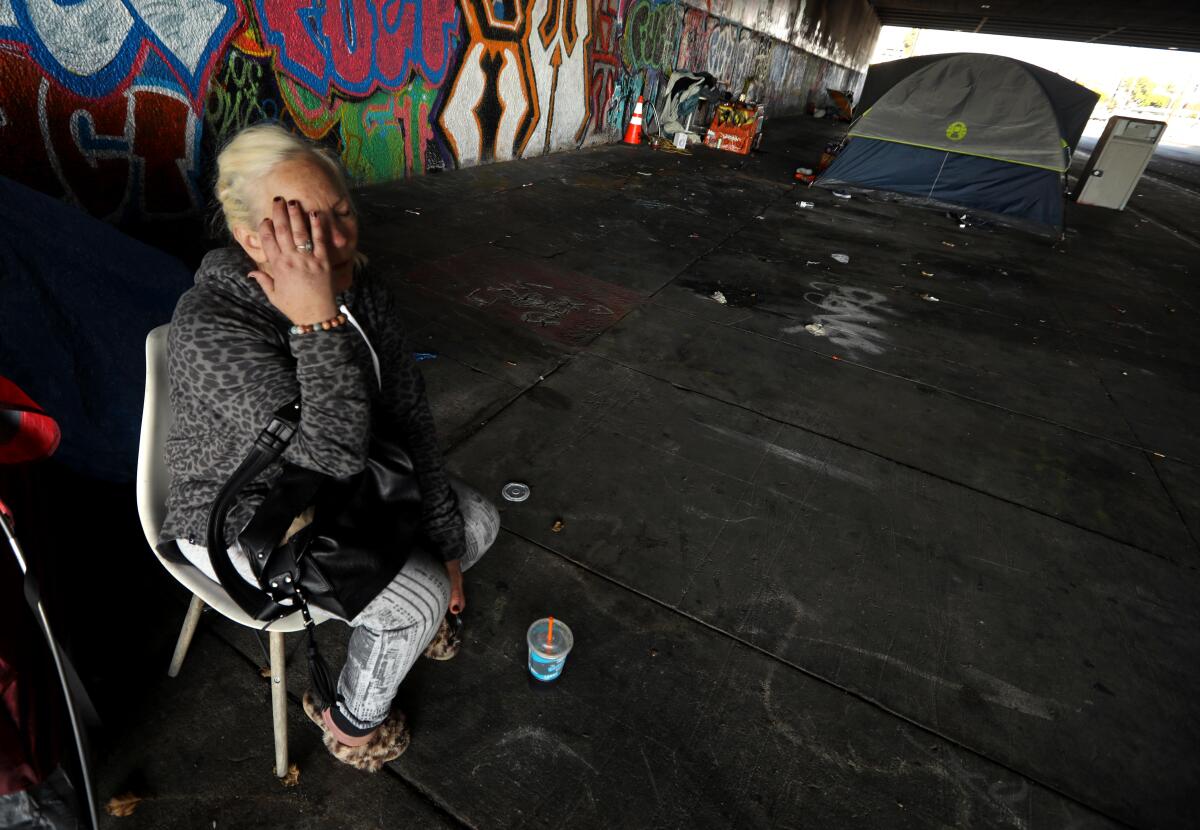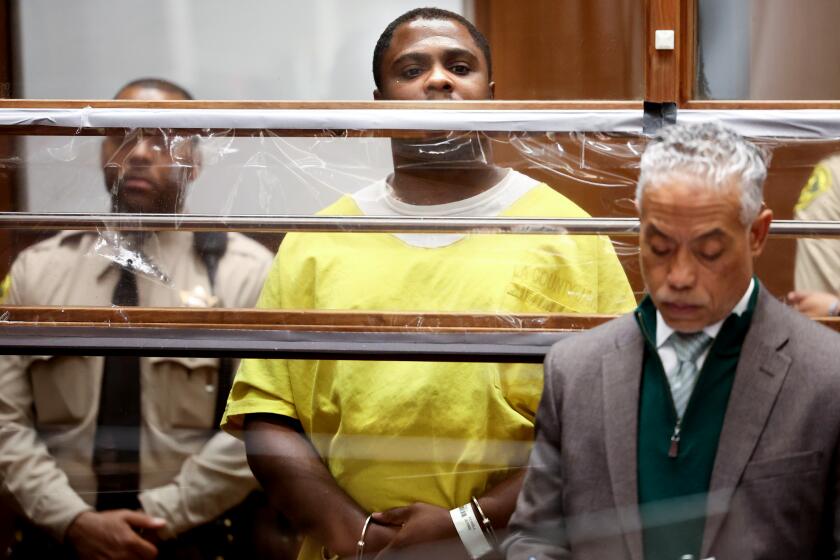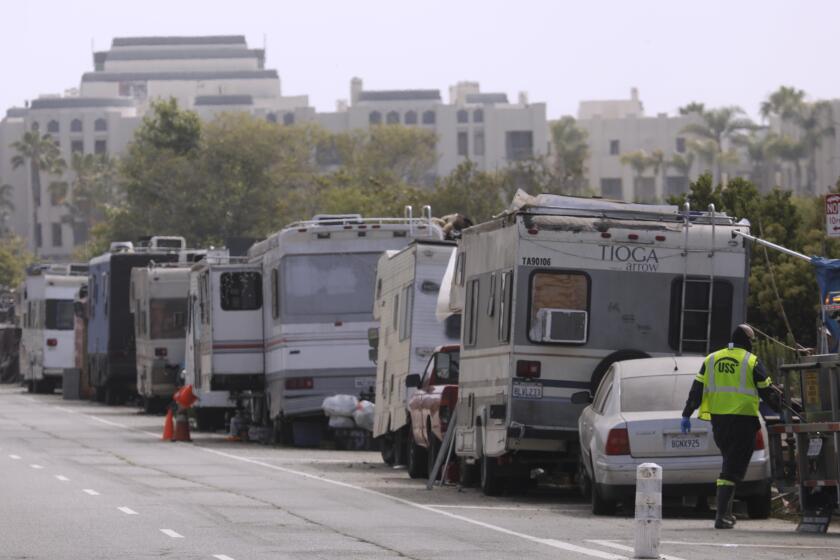Is L.A. actually solving homelessness? The answer will start with perception, not reality

- Share via
For as long as people have watched tents take over sidewalks and RVs deteriorate under freeways, politicians have been making promises about solving homelessness in Los Angeles.
And for just as long, those same politicians have been breaking them.
This is undoubtedly why, back in March, as Mayor Karen Bass was approaching her first 100 days in office, only 17% of Angelenos believed her administration would make “a lot of progress” getting people off the streets, according to a Suffolk University/Los Angeles Times poll. Far more — 45% — predicted just “a little progress” would be made.
I was thinking about this deep well of public skepticism while listening to Bass, all smiles in a bright green suit on Wednesday morning, enthusiastically explain why the progress she has actually made is a reason for renewed optimism.
Bass, marking her first year as mayor, said the numbers show the strides her administration has made in getting homeless residents off the street and under a roof.
Flanked by members of the L.A. City Council outside a school in Hollywood, she announced that her administration had, in its first year, moved 21,694 people out of encampments and into interim housing. That’s an increase of 28% over the final year of former Mayor Eric Garcetti’s administration, taking into account the work of various government programs, including Bass’ signature one, Inside Safe.
In addition, the majority of those directed to motel and hotel rooms, congregate shelters and tiny homes have decided to stay, rather than head back out onto the streets.
“We have tried to set a new tone in the city. This is an example of that new tone. Forty-one people used to sleep here, and now it’s clear,” Bass said Wednesday over the shrieks of schoolchildren. “Students and parents don’t need to walk around tents on their way to school, and the Angelenos who were living here do not need to die on our streets.”
It was a convincing message, backed up by a thick packet of numbers distributed to reporters at City Hall a few hours later.
But numbers are funny. They can be crunched in many ways and interpreted to mean many different things.
As my Times colleague David Zahniser pointed out, all of the people who now live in interim housing are still considered homeless by the federal government. And while Bass had originally thought most of them would be there for only three to six months, it’s now looking more like 18 months to two years. Permanent housing is that scarce.
So, numbers-wise, don’t expect a decline in the next annual homelessness count, which is scheduled for January. There might even be an increase, thanks to the expiration of pandemic-era tenant protections. As of the last count, there were more than 46,000 unhoused people living in the city, mostly in encampments.
But again, numbers are funny. They tend not to mean half as much as what people see and experience for themselves, just like the disconnect between public perceptions of crime and actual crime data.
So, when Bass declares at a news conference that “we have proved this year that we will make change,” and she talks about the encampment that used to be where she’s standing and all the encampments that her administration has cleared, even if a few more tents have popped up down the street, skeptical Angelenos just might believe her.
And maybe, just maybe, that’s not such a bad thing.
“What I see most powerfully is increased hope,” Va Lecia Adams Kellum, chief executive of the Los Angeles Homeless Services Authority, told reporters on Wednesday. “Hope among the folks who are living in those encampments who had given up and [thought] they’ll always live in that level of despair. Hope that the community now believes that we could possibly get out of this terrible crisis.”

Hope is a thing difficult to quantify, especially among people who have been homeless for years, and have suffered so much and have been let down so often by government.
I’ve talked to some who took a chance and decided to leave their tents and RVs, and are now thrilled to be in a motel room with a door, running water and air conditioning. Others have had it with curfews and jail-like rules, and are getting tired of waiting on promised permanent housing.
I’ve also talked to those who have been booted out of interim housing for one reason or another, and are back on the streets. They are feeling hopeless, like many cash-strapped Angelenos who are on the verge of an eviction.
But peak hopelessness? That’s what we saw on the first days of December.
At a hastily called news conference, Los Angeles Police Chief Michel Moore announced that officers were searching for a man who had fatally shot three homeless people — one sleeping on a couch in an alley and another while pushing a shopping cart.
“This is a killer preying on the unhoused,” Bass said.
Moore and Bass didn’t know then, but their suspect, Jerrid Joseph Powell, had already been arrested by Beverly Hills police after a traffic stop in which his $60,000 BMW was linked to a deadly follow-home robbery.
Police have yet to elaborate on Powell’s alleged motive, but Bass brought up the horrific case several times on Wednesday — and with good reason. Violence and acts of cruelty against people living on the streets are increasingly common not just locally, but nationally.
In addition to shootings, there have been stabbings and beheadings. And let’s not forget about the gallery owner in San Francisco who was caught on video spraying a homeless woman with a hose.
More than a week after the arrest of Jerrid Joseph Powell in connection with the shooting deaths of three homeless men and an L.A. county employee, much remains wrapped in mystery, including a motive in the slayings.
Advocates blame this trend of nastiness on the pandemic-era surge in homelessness, particularly in unsheltered homelessness, and the subsequent spike in interactions between housed and unhoused residents. Fear and frustration can lead to dehumanization and that, in turn, can lead to violence, said Dr. Margot Kushel, director of the Benioff Homelessness and Housing Initiative in San Francisco.
“I do really worry that it’s become normalized in public discourse to speak about people experiencing homelessness as, like, a problem for those who are not homeless — as opposed to fundamentally a massive societal failure that’s left usually older, vulnerable people terrified and totally unprotected,” she told me. “And I do think that there is a connection, like the more we dehumanize people, the less protected they are.”
Stephanie Klasky-Gamer has watched this happen in real time as president and CEO of L.A. Family Housing. The seeming permanency of encampments, and the trash, fires and unsanitary conditions they often generate, have led to what she describes as widespread impatience.
“I don’t mean big, systemic impatience, like ‘I wish we could end homelessness faster,’” she said. “It’s the ‘I’m just sick of seeing you in front of me’ kind of impatience.”
On some level, she gets it, though. As does Kushel. As do I.
“It has to be OK to say, ‘Yeah, this sucks that I’m walking my kids to school and I’m walking over people in tents,’” Kushel told me. “But there has to be a way to hold that with being able to recognize how we got to this position and also how we’re going to get out. And to sort of restore [our] collective humanity.”
For Klasky-Gamer, this has meant focusing on what has changed since Bass became mayor.
“I know how much good is getting done,” she told me. “The frustration I may feel at seeing the tent every day I turn the corner, at least I can temper it knowing that 10 people yesterday moved into an apartment. These three people haven’t. But these 10 did.”

The mayor has told me many times that getting people off the streets isn’t just a humanitarian imperative — and, as a serial killer reminded us, a safety imperative. It’s also a demonstration to a fed-up public that progress is possible.
“What distresses Angelenos the most are encampments. That’s where people were dying on the street,” Bass told reporters. “And to me, what was clear, was that we come up with a way to get people out of the tents.”
Some will dismiss that. They’ll insist that all her administration is doing is reducing visible homelessness to score easy political points. And that instead of doing the hard work of actually helping L.A.’s most vulnerable residents get back on their feet, the mayor is hiding them so that they’ll be forgotten and abandoned in interim housing.
In this city, defined by its haves and have-nots, I understand the cynicism and skepticism. But that’s why what Bass does next, namely expanding and stabilizing the city’s crumbling supply of permanent housing, will matter even more than what she has done thus far.
“We’ve got to somehow make people believe again that this is solvable,” Kushel told me, “and it is solvable.”
Hope can be elusive. But Annelisa Stephan was looking for it anyway when she came to the Ballona Wetlands on a recent Saturday morning.
She and more than 100 other volunteers — many of them from the nearby neighborhoods of Playa Vista and Playa del Rey — had descended on the Westside ecological reserve to dig holes, spread soil, and put in plants and trees.
Just a few months ago, RVs had been parked here along Jefferson Boulevard, bumper to bumper in a sprawling encampment that dozens of unhoused people had come to call home.
They built a close-knit community, looking out for one another and mourning one another after deadly fires. But they also decimated the Ballona Wetlands’ freshwater marsh with everything from battery acid to trash to human waste, and scared off nearby residents who once walked the trails.
What has been unfolding at the Ballona Wetlands represents a new model to fix a complicated homelessness problem that’s mostly of L.A.’s own making.
And then one day, after almost three years, the encampment was gone, replaced by concrete barricades and metal fencing. The residents were mostly sent to interim housing and the RVs were mostly towed away.
“It’s like, hard to know what to think or feel,” Stephan told me. “I’m happy that the land is being stewarded, but just sad about the suffering that so many people face.”
She lamented the “fervent, anti-homeless mania” that she has heard from some of her neighbors.
“It’s just been really a painful time,” Stephan said.
L.A. City Councilmember Traci Park, whose Westside district includes the Ballona Wetlands and got elected on promises to aggressively crack down on homeless encampments, was more circumspect.
“At the end of the day, everybody wants the same thing, which is to get folks off the streets and into safe settings and connected to the help that they need,” she said while watching volunteers dig holes. “There’s a lot of different points of view about how we get there. And I think that’s where a lot of the conflict and the division lie.”
She paused, as traffic whizzed by on Jefferson Boulevard.
“But,” Park said, “we have great leadership.”
More to Read
Sign up for Essential California
The most important California stories and recommendations in your inbox every morning.
You may occasionally receive promotional content from the Los Angeles Times.

















